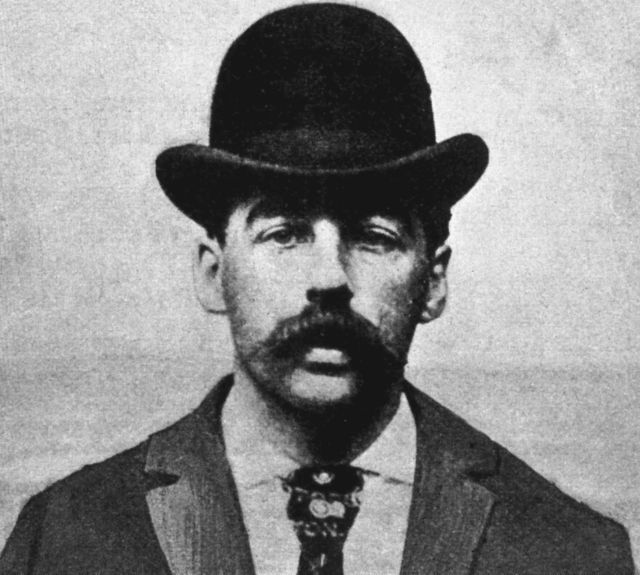Meet The Serial Killer Leonardo DiCaprio Will Play In 'Devil In The White City'
By Margaret Paulson in Arts & Entertainment on Aug 12, 2015 7:25PM

Are you pumped about the upcoming movie adaptation of The Devil in the White City? Thought so. We are too, especially because it’s a DiCaprio-Scorcese mash-up (a la Gangs of New York, The Aviator, and Shutter Island, among others).
But if ever there were a question to be had about the success of this film, that question is this: How will sweet-faced, upstanding Leo possibly be able to transform into the conniving, sinister and murderous Dr. H. H. Holmes? And more pressingly—do we want him to?
Sure Leo did more than justice to the cunning but cute Frank Abagnale, Jr., the mercurial Howard Hughes, and the mostly harmless, terribly handsome and sadly fictional Jay Gatsby.
But Dr. H. H. Holmes is a veritable monster, a man without a pure bone in his body, and the exact opposite of how we see Leo.
While Dr. H. H. Holmes’ earliest deceits were weird and nearly comical, centered around elaborate plots and trickery—not murderous, though morbid—for financial gain. But they pooled into something altogether more sinister on an unbelievable scale: He developed a career in mass-murder during the 1893 Columbian World Exposition in Chicago, with countless untold victims, and seemed to kill for thrill and curiosity above anything else, though money always played a role.
If you want to read the full story of a true psychopathic mastermind whose deceits were numerous and capacity for the sinister mind-boggling, check out this truly remarkable story from the archives, a December 1943 issue of Harper’s Magazine titled “The Master of the Murder Castle.”
There’s much unknown about The Devil in the White City, like the exact number of victims, but we’ve summed up the most horrifying facts for you here:
- His name was actually Herman Webster Mudgett, and he wasn’t a real doctor though he did attend medical school at the University of Michigan, which is where his fascination with the sinister apparently began. He started stealing cadavers, pretending the people had recently died, and collecting insurance money on them.
- Though there are reports that he may have tortured and performed experiments on animals as a child, Holmes’ early crimes involved making deals and racking up credit before backing out, making money off of them, and disappearing. He seems to have been agile in fashioning excuses and pushing people off, doing things that would be comical if we didn’t know the end result of it all. For example, Holmes once bought a bunch of furniture he couldn’t pay for, and when the company came to collect everything, he had put it all in one room, built a brick wall, and papered over it so it appeared everything was gone. Another time, he bought a very large safe on credit, then made the door frame smaller so it couldn’t be removed easily from the room. When the company came to collect it, he said they could take it but he’d sue them if they damaged his building.
- Holmes had three wives and numerous mistresses, most of whom ended up dead. He somehow smooth-talked his way into the lives of wealthy, beautiful women and stole their money before killing them. One wife was a wealthy woman who lived in their family home in Winnetka with the children and seemed to have no idea about his comings and goings. The second wife, Minnie Williams, may have been an accomplice, but it’s uncertain, considering their apartments were separate from the rooms where the horrors took place. Holmes ended up swindling property from her before killing both Williams and her sister.
- His “Murder Castle” was located in Englewood. The first floor had shops, the third had his apartments, and the second floor and cellar where he used to kill, experiment on the bodies, and ultimately bury or get rid of them. The Murder Castle had 100 rooms, stairs leading nowhere, blind passageways, false partitions, rooms with no doors and rooms with too many doors, all located on the second floor. There were also trap doors leading to the cellar, through which Holmes’ would shuttle bodies. He also had gas chambers, was known to kill with chloroform, and installed a buzzer system that would ring in his apartment if someone tried to escape.
- Aside from making money by collecting insurance policies off of the deceased, Holmes sold their bones or the cadavers to universities and medical schools for research. He may have also done experiments on the bodies himself.
- Holmes’ ultimate downfall was when creditors began coming after him. He ended up killing a fellow accomplice through an elaborate ruse and then collected life insurance on the man, which led to his arrest.
- The majority of Holmes' victims were women that he was dating or purported to hire as "typewriters" or stenographers. He also wasn't opposed to killing children and anyone who got in his way.
Creeped out enough yet? If not, perhaps you'll want to check out the local post office that is supposedly on the site of Murder Castle.
You sure about this, Leo?